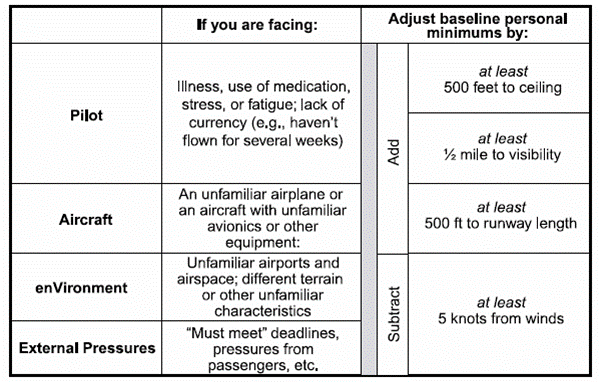|
Any flight you make involves almost infinite combinations of pilot skill, experience,
condition, and proficiency; aircraft equipment and performance; environmental conditions;
and external influences. Both individually and in combination, these factors can compress the
safety buffer provided by your baseline personal minimums. Consequently, you need a practical
way to adjust your baseline personal minimums to accommodate specific conditions. See the
chart below for an example of how this adjustment can be done.

Note that the suggested adjustment factors are just that -- a suggestion. If your flying
experience is limited or if you don't fly very often, you might want to double these values.
In addition, if your situation involves more than one special condition from the chart above,
you will probably want to add the adjustment factor for each one. For example, suppose you
are planning a night cross-country to an unfamiliar airport, departing after a full workday.
If you decide to make this trip -- though you might decide that it is safest to wait until the
next day -- this chart suggests that you should at least raise your baseline personal minimums
by adding 1,000 feet to your ceiling value; one mile to visibility, and 1,000 feet to required
runway length.
How about adjustments in the other direction? Some pilots fear that establishing personal
minimums is a once-and-for-all exercise. With time and experience, though, you can modify
personal minimums to match growing skill and judgment. When you have comfortably flown to
your baseline personal minimums for several months, you might want to sit down and assess
whether, and how, to safely push the envelope. If, for instance, your personal minimums call
for daytime visibility of at least five miles, and you have developed some solid experience
flying in those conditions, you might consider lowering the visibility value to four miles
for your next flight.
Two important cautions:
First, never adjust personal minimums to a lower value for a
specific flight. The time to consider adjustments is when you are not under any pressure to
fly, and when you have the time and objectivity to think honestly about your skill, performance,
and comfort level during last the few flights. Changing personal minimums "on the fly" defeats
the purpose of having them in the first place.
Second, keep all other variables constant. For example, if your goal is to lower your
baseline personal minimums for visibility, don't try to lower the ceiling, wind, or other
values at the same time. In addition, you never want to push the baseline if there are special
conditions (e.g., unfamiliar aircraft, pilot fatigue) present for this flight.
You might find it helpful to talk through both your newly-established personal minimums and
any "push-the-envelope" plans with a well-qualified flight instructor.
|


